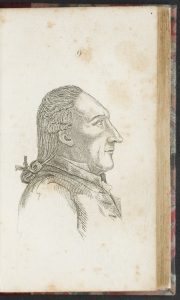The Pocket Lavater, or, The Science of Physiognomy: to Which is Added an Inquiry into the Analogy Existing Between Brute and Human Physiognomy, from the Italian of Porta


Pastor and writer Johann Caspar Lavater (1741-1801) was the leading proponent of the discipline of physiognomy, which was popular in late 18th century Europe. With its origins dating back to writings of the Greek philosophers, and drawing from the writings of English physician Sir Thomas Browne and Italian scholar Giambattista della Porta, physiognomy proposed a direct correlation between a person’s outward appearance – particularly in the face and shape of the head – and their personality. Illustrations like these were a precursor to those of later phrenologists, but were also an attempt to capture in the face what could not yet be seen in the brain itself.
This quick reference “pocket” edition of Lavater’s work contains 32 caricature illustrations emphasizing varied combinations of unique facial features and a brief description of the type of personality associated with them. Widely discredited as a pseudoscience in the 19th century, aspects of phyisognomy nonetheless influenced the development of later disciplines, including criminology and more recently facial recognition technology.
